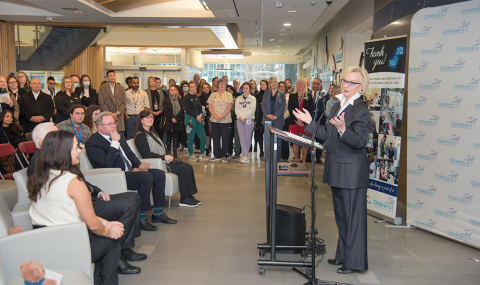Program Description:
The Emergency Services Program is an innovative, dynamic, and progressive program consisting of three state of the art emergency departments situated on two sites. Then departments, located at University Hospital and Victoria Hospital, offer tertiary/quaternary services to London and the surrounding region within a teaching
environment. These departments, which focus on various sub-specialties within emergency care, provide family centred care environments complete with an electronic Patient Tracking System. The goal of our departments is to offer professionally challenging opportunities in the specialty of emergency care for nurses across the
career span.
London Health Sciences Centre Emergency Departments serve more than 140,745 patients per year.
University Hospital Emergency Department
In the summer of 2003, the University Hospital Emergency Department tripled in size by moving to a brand new location. There are approximately 47,000 visits annually serving both adult and paediatric clientele. The core services offered at this site are Clinical Neurosciences, full range Cardiology Services, Organ Transplantation, Orthopaedics, Critical Care, Medicine, and General Surgery. This site is the home of regional cardiac and stroke referral programs.
Victoria Hospital Emergency Departments
Adult Emergency Department
In June 2005, the oldest and most established Emergency Department in the city moved to a new department. This site is the lead Trauma Centre for the region and also specializes in Acute Mental Health Services, and Oncology Services, as well as Critical Care, Medicine, Cardiology and General Surgery Services. Annually this site cares for
59,000 patients.
Children’s Emergency Department
Recognized in the region for providing quality paediatric care, the Children’s Emergency Department specializes in the care of patients less than 18 years of age. Children’s Emergency functions as the Paediatric Trauma Centre and is the gateway to the
Children’s Hospital of Western Ontario.This department is supported by a wide variety of Paediatric clinical specialties. Annually this site cares for approximately 36,000 patients.
General Information:
University Hospital Emergency Department
- Number of patient care areas: 40
- Team Composition: all RN staff, charge nurse on every shift, Clinical Educator, Coordinator, Manager, Emergency Medicine Consultants, Medical Residents, Social Worker, PSA/TSA, Communication Clerks, Geriatric Emergency Management Nurse
Clinician, and a Community Care Access Centre Case Manager.
- Nurse to patient ratio: Resuscitation Room 1:1, Acute Room 1:3, Ambulatory area 1:4
- Non-unionized site.
Victoria Hospital Emergency Departments
Adult Emergency Department
- Number of patient care areas: 43
- Team Composition: all RN staff, charge nurse on every shift, Clinical Educator,Coordinator, Manager, Emergency Medicine Consultants, Medical Residents, Orderlies, Social Workers, PSA/TSA, Unit Clerks and Community Care Access
Centre Case Manager.
- Nurse to patient ratio: Trauma Room 1:1, Acute Room 1:4, Ambulatory area 1:6
- Unionized site
Children’s Emergency Department
- Number of patient care areas: 23
- Team Composition: all RN staff, charge nurse on every shift, Clinical Educator, Coordinator, Manager, Emergency Medicine Consultants, Paediatric fellow, Medical Residents, Child Life Specialists, Social Worker, PSA/TSA, and Unit Clerks.
- Nurse to patient ratio: Trauma/Resuscitation Room 1:1, Acute Room 1:3, Ambulatory area 1:4
- Unionized site
Scheduling Information:
University Hospital Emergency Department
- Shift times: 0730-1930, 0730-1530, 0930-1930, 1130-1930, 1000-2200, 1300-2300,1500-0100, 2330-0730, and 1930-0730.
- Shift options: 12 hours shifts, 10 shifts, & 8 hour shifts. Available in fulltime, reduced fulltime, job share, self scheduled part time, scheduled part time, and casual positions.
- Shift rotations: traditional 2 weeks 12 hour rotation (2 weeks days, 2 weeks nights), full time DDNN rotation (4 on, 5 off), 10 hour rotation, and permanent 1000-2200.
Victoria Hospital Emergency Departments
Adult Emergency Department
- Shift times: 0700-1900, 0700-1500, 1100-2300, 1900-0700, and 2300-0700.
- Shift options: 12 hours shifts & 8 hour shifts. Available in fulltime, job share, scheduled part time, and casual positions.
- Shift rotations: traditional 2 weeks 12 hour rotation, 12 hour DDNN (4 on, 5 off), and weekend worker.
Children’s Emergency Department
- Shift times: 0800-2000, 0800-1600, 1200-2400, 2000-0800, and 2400-0800.
- Shift options: 12 hours rotating shifts. Available in fulltime, job share, scheduled part time, and casual positions.
- Shift rotations: traditional 2 week 12 hour rotation and 12 hour DDNN (4 on, 5 off).
Background Essentials:
- Current BCLS, physical assessment skills, basic airway management skills,
- Current registration with the College of Nurses of Ontario
Professional Assets:
- Minimum of one-year experience in a medical or surgical environment adult and/or paediatric preferred.
- Cardiac monitoring interpretation skills
- Experience in emergency nursing.
- Completion of a Certificate Program in Emergency Nursing.
- Certification in Emergency Nursing, ENC(C)
- Baccalaureate Degree in Nursing
- Current verification in Advanced Cardiac Life Support (ACLS), Paediatric
- Advanced Life Support (PALS), Trauma Nursing Core Course (TNCC), an
- Emergency Nursing Paediatric Course (ENPC).
Professional Development:
Newly hired nurses in the Emergency Care Program receive a 2-week citywide classroom orientation. A preceptorship period consisting of a minimum of 8 twelve hours shifts, tailored to the individual needs of the nurse, follows the classroom sessions.
Currently, there are 3 Clinical Educators to assist with the professional development needs of the prospective employees. Workshops, Skills Fairs, Update Days, Conferences, ACLS, TNCC, and PALS Courses, and the provision of learning materials are some of the avenues of ongoing learning facilitated by the education team. Full or partial funding may be available for qualified individuals for core courses and
certifications.
We partner and support the Emergency Nursing Certificate Program through Fanshawe College and support certification in the specialty of emergency nursing through the Canadian Nurses Association.
Student Consolidation:
- We offer consolidation experience for 4th year university basic nursing students both locally and provincially as well as opportunities for a clinical practicum for post diploma BScN students.
- We provide a clinical practicum for nurse practitioner students.
- Paramedics student placements facilitated through Fanshawe College are also available.
Program Links:
- Our internal website is located at http://www.lhsc.on.ca/priv/ecp/
- This website provides contact information, our Medical Directives, and information about educational opportunities.
- Associations specific to Canadian emergency nurses are the Emergency Nurses Association of Ontario at http://www.enao.on.ca/ and the National Emergency Nurses Affiliation at http://www.nena.ca/
- An international link for emergency nurses is the Emergency Nurses Association at http://www.ena.org/
- An excellent journal for emergency nurses is the Journal of Emergency Nursing which available electronically through our Library Services link.
- We strongly recommend certification in emergency nursing through the Canadian Nurse Association. For information go to
http://cna-aiic.ca/CNA/nursing/certification/default_e.aspx


